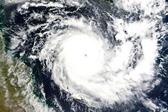
Depending on where you live, there may be special requirements for fire or cyclone codes. See how these affect you.
Each year, Australian lives are lost due to the inability of their homes to protect them from extreme weather conditions and natural disasters. Many of those lucky enough to survive catastrophic events must still deal with the repercussions of losing homes and belongings, which involves long-term financial and emotional costs. Experience has taught us that some areas are more prone to catastrophic natural events (such as bushfires and cyclones) than others. Building codes for homes built in these localities often include extra regulations which aim to keep homes and their occupants safe and standing.

Image courtesy of NAA, A6180, 31/12/74/19.
Cyclones and strong winds
Cyclone Tracy hit a vastly unprepared Darwin in late 1974, demolishing up to 80% of homes and forcing the evacuation of more than half of the city’s 47,000 residents. 71 lives were lost. For residents of one of Australia’s capital cities to experience such widespread homelessness due to an event such as a cyclone was clearly unacceptable, and scientists worked with the government to improve standards and regulations for homes built in the city. Today the Australian Building Code has cyclone and strong wind compliance requirements for walls in the majority of Australia’s coastal areas. This includes towns and cities in Western Australia, the Northern Territory and Queensland.
In a cyclone or strong wind storm, building damage and collapse often occurs when the wind is allowed into a building. The internal pressure causes roofs and ceilings to lift and walls to be pushed outwards. Ideally, wind should be prevented from entering the building in the first place. However, in the event that it does, extra-strong fasteners should help in keeping the roof securely fastened. Walls and ceilings can be braced with plywood or oriented strand board to help combat the horizontal wind pressure.
Wind load
Where your home is situated can have a big impact on how badly it is affected by strong winds and cyclones. Calculating the ‘wind load’ of a potential building site can give you an indication of what measures you might need to take to ensure structural competency. A house surrounded by trees and other buildings will be better shielded from wind than a house on its own.
Site elevation is another factor in considering your wind load – the higher the site, the higher the wind load. An isolated house on the top of a hill is going to have a higher wind load than homes built closely together at the bottom of a valley, and may therefore need extra structural support.
Maintenance
Maintenance is a key issue for homes in regions prone to cyclones and strong winds. Even homes that have been built ‘to code’ can be damaged or collapse if they are allowed to deteriorate. According to publications produced by the Northern Territory government, dwellings and buildings such as garages and sheds need to be regularly checked for corrosion, rot, termite and other insect attacks, and general weathering.
Cyclone safe room
Residents of regions prone to cyclones and strong winds should have a safe place to shelter on their property. This should be a small room with reinforced concrete walls and a concrete ceiling if possible. If the walls are not concrete you should consider additional strengthening measures for the room’s walls and ceiling.





